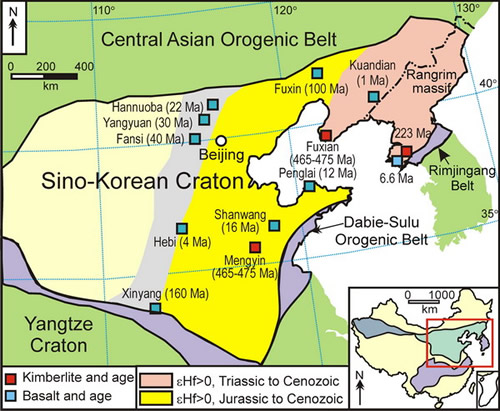Diachronous Decratonization of the Sino-Korean Craton: Geochemistry of Mantle Xenoliths from North KoreaUpdate time:09 26, 2010
Ancient cratons are typically characterized by thick lithospheric-mantle roots that provide them with buoyancy and rigidity. Once formed, cratons, including their roots, move around Earth’s surface as parts of rigid lithospheric plates that are normally unaffected by strong magmatism or tectonic activity, in contrast to younger orogenic belts. Considerable geophysical and geochemical evidence, however, suggests that the ancient lithospheric mantle beneath the Chinese portion of the eastern Sino-Korean Craton was replaced by thinner, hotter, juvenile mantle during the Jurassic to early-Cretaceous. The extent and cause of the changes to this lithospheric mantle have been highly debated. Keys to deciphering the history of the changes include knowledge of both the lateral extent of the lithospheric modifications, and the relative timing of change across the craton. As the easternmost part of the Sino-Korean Craton, discerning the age and structure of lithospheric mantle underlying North Korea is, thus, particularly important. Here we report mineral compositions and Re-Os isotopic data for peridotite xenoliths from North Korean Triassic kimberlites and Tertiary basalts. The data suggest that, from the Triassic to the present, North Korea has been underlain by young, hot and fertile lithospheric mantle, unlike typical cratonic lithospheric roots, but similar to the juvenile lithospheric mantle underlying Chinese portions of the craton. Given the generally ancient nature of the crust comprising North Korea, our findings suggest that modification of underlying cratonic roots extended to the eastern edge of the craton. The Triassic eruption age of some of the xenoliths suggests the lithospheric changes may have occurred at least 50 Ma earlier than in China, indicating that lithospheric removal occurred over a prolonged interval, and evolved from east to west. These results are most consistent with the conclusion that lithospheric loss was initially triggered by extension that followed the collision between the Sino-Korean and Yangtze cratons.
Figure 1. Map showing the distribution of xenolith-bearing kimberlites and Mesozoic to Cenozoic alkaline basalts with ages and the age distribution of magmas with depleted mantle signatures (eHf(t) > 0) in the eastern SKC.
Figure 2. (A) Os-isotope data for peridotite xenoliths and their sulfides from the Late Triassic kimberlites and Cenozoic basalts, compared with those of peridotite xenoliths in the mid-Ordovician kimberlites and Cenozoic alkaline basalts in the eastern SKC.. (B) Isotopic compositions of Sr and Nd in clinopyroxenes from peridotite xenoliths in the Late Triassic kimberlite, compared with those of clinopyroxenes from xenoliths in the mid-Ordovician kimberlites and Cenozoic alkaline basalts.
|
Contact
Related Articles
Reference
|
-
SIMSSecondary Ion Mass Spectrometer Laboratory
-
MC-ICPMSMultiple-collector ICPMS Laboratory
-
EM & TEMElectron Microprobe and Transmission Electron Microscope Laboratory
-
SISolid Isotope Laboratory
-
StIStable Isotope Laboratory
-
RMPARock-Mineral Preparation and Analysis
-
AAH40Ar/39Ar & (U-Th)/He Laboratory
-
EMLElectron Microscopy Laboratory
-
USCLUranium Series Chronology Laboratory
-
SASeismic Array Laboratory
-
SEELaboratory of Space Environment Exploration Laboratory
-
PGPaleomagnetism and Geochronology Laboratory
-
BioMNSFrance-China Bio-mineralization and Nano-structure Laboratory

 Print
Print Close
Close

